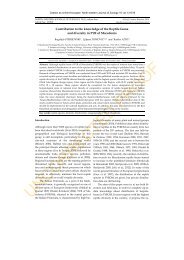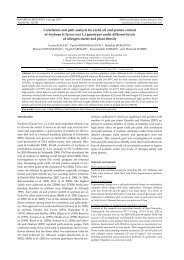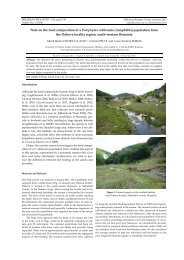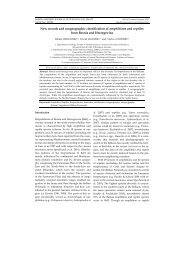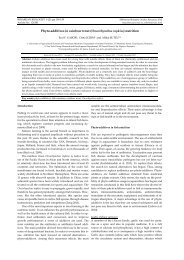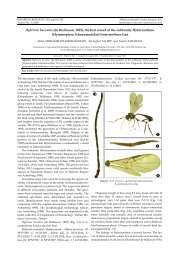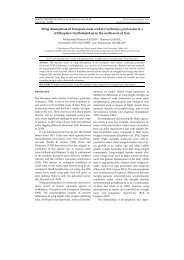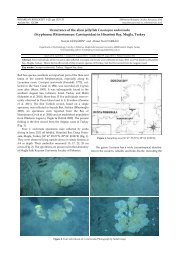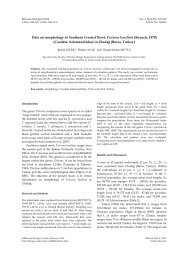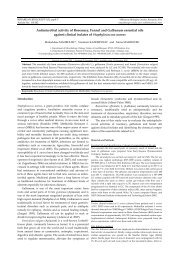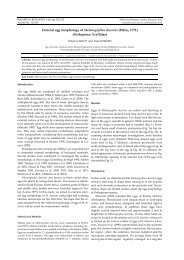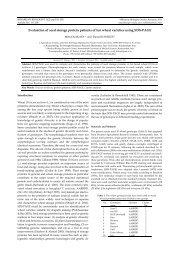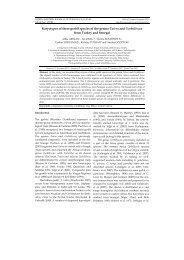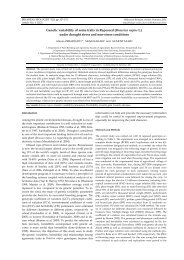Faunistic Study of Sand Flies in Northern Cyprus - North-Western ...
Faunistic Study of Sand Flies in Northern Cyprus - North-Western ...
Faunistic Study of Sand Flies in Northern Cyprus - North-Western ...
Create successful ePaper yourself
Turn your PDF publications into a flip-book with our unique Google optimized e-Paper software.
<strong>North</strong>-<strong>Western</strong> Journal <strong>of</strong> Zoology Vol. 6, No. 2, 2010, pp.149-161<br />
P-ISSN: 1584-9074, E-ISSN: 1843-5629 Article No.: 061114<br />
Introduction<br />
<strong>Faunistic</strong> <strong>Study</strong> <strong>of</strong> <strong>Sand</strong> <strong>Flies</strong> <strong>in</strong> <strong><strong>North</strong>ern</strong> <strong>Cyprus</strong><br />
Samiye DEMIR 1,*, Bayram GOCMEN 2 and Yusuf OZBEL 3<br />
1. Mustafa Kemal University, Faculty <strong>of</strong> Science and Arts, Department <strong>of</strong> Biology, Zoology Section, 31000 Hatay, Turkey<br />
2. Ege University, Faculty <strong>of</strong> Science, Department <strong>of</strong> Biology, Zoology Section, 35100 Bornova, Izmir, Turkey<br />
3. Ege University, Medical Faculty, Department <strong>of</strong> Parasitology, Izmir, Turkey<br />
*Correspond<strong>in</strong>g Author: S. Demir, E-mail: demirsamiye@gmail.com,<br />
Tel: +90 (326) 245 58 66/1634, Fax: + 90 326 245 58 67<br />
Abstract. A faunistic study <strong>of</strong> Phlebotom<strong>in</strong>ae (Diptera: Psychodidae) sand flies was carried out <strong>in</strong><br />
northern <strong>Cyprus</strong>. A total <strong>of</strong> 12,517 sand flies (3,285 males and 9,232 females) was collected from 20<br />
different localities <strong>in</strong> July and September 2004. N<strong>in</strong>e species belong<strong>in</strong>g to genus Phlebotomus and 3 species<br />
<strong>of</strong> genus Sergentomyia were identified. Of these, the presence <strong>of</strong> the species Phlebotomus neglectus<br />
Tonnoir was reported for the first time <strong>in</strong> <strong>Cyprus</strong>, while P. jacusieli Theodor, P. kyreniae Theodor and<br />
P. economidesi Léger, Depaquit & Ferté were reported from the island for only the second time.<br />
However, P. mascittii Grassi which was previously reported from southern <strong>Cyprus</strong> was not found <strong>in</strong><br />
this study. The most abundant species for the overall northern <strong>Cyprus</strong> were P. galilaeus Theodor<br />
(60.88%), P. papatasi Scopoli (15.67%) and P. tobbi Adler & Theodor (12.47%). These three species<br />
account for 89.02% <strong>of</strong> all sand flies collected <strong>in</strong> this survey. Because <strong>of</strong> the previously reported<br />
parasitic diseases such as human and can<strong>in</strong>e visceral leishmaniasis, cutaneous leishmaniasis and<br />
viral diseases such as sand fly fever, the distribution <strong>of</strong> the sand fly species belong<strong>in</strong>g to genus<br />
Phlebotomus found <strong>in</strong> northern <strong>Cyprus</strong> and their vectorial status were discussed and the results were<br />
compared with previous reports.<br />
Key words: Phlebotomus, Sergentomyia, <strong>Cyprus</strong>, sand fly.<br />
<strong>Cyprus</strong> is the third largest island (9,251 km 2)<br />
situated <strong>in</strong> the north eastern corner <strong>of</strong> the<br />
Mediterranean Sea. It is located <strong>in</strong> 34 o33’ -<br />
35 o42’ northern latitudes and 32 o16’ - 34 o36’<br />
eastern longitudes. The landscape <strong>of</strong> <strong>Cyprus</strong> is<br />
characterized by mounta<strong>in</strong>s and pla<strong>in</strong>s. The<br />
two highest mounta<strong>in</strong> ranges <strong>of</strong> <strong>Cyprus</strong> are<br />
Troodos, that covers most <strong>of</strong> the southern and<br />
western portions <strong>of</strong> the island, and Pentadactylos,<br />
which runs along most <strong>of</strong> the north<br />
coastl<strong>in</strong>e. The neighbors <strong>of</strong> <strong>Cyprus</strong> are Turkey,<br />
70 km to the north, Syria and Lebanon, 102 km<br />
and 65 km to the east respectively, Egypt, 232<br />
km to the south-east and Greece, 835 km to the<br />
north-west (Göçmen et al. 2008). The mounta<strong>in</strong>s<br />
are separated by the Central Mesaoria<br />
Pla<strong>in</strong> that extends the length <strong>of</strong> the island from<br />
east to west and is generally marked as a<br />
breadbasket <strong>of</strong> <strong>Cyprus</strong>, ow<strong>in</strong>g to the production<br />
<strong>of</strong> cereal crops such as wheat, barley and<br />
oats. <strong>Cyprus</strong> has three different vegetation<br />
zones due to its topography, which are; Pentadactylos<br />
Mounta<strong>in</strong>s vegetation zone, <strong>in</strong>ner vegetation<br />
zone and Troodos Mounta<strong>in</strong>s vegetation<br />
zone (Göçmen et al. 2008).<br />
<strong>Cyprus</strong> has the Mediterranean climate,<br />
warm and ra<strong>in</strong>y <strong>in</strong> w<strong>in</strong>ter and hot and dry <strong>in</strong><br />
summer. Ra<strong>in</strong>fall is rare and only occurs <strong>in</strong><br />
w<strong>in</strong>ter <strong>in</strong> pla<strong>in</strong> areas. The mean daily temperature<br />
<strong>in</strong> July and August ranges between 29°C<br />
on the central pla<strong>in</strong> to 22°C <strong>in</strong> the Troodos<br />
mounta<strong>in</strong>s, while the average maximum temperature<br />
for these months ranges between 36°C<br />
and 27°C, respectively. Relative humidity <strong>of</strong><br />
©NwjZ, Oradea, Romania, 2010 <strong>North</strong>-West J Zool, 6, 2010<br />
www.herp-or.uv.ro/nwjz Oradea, Romania
150<br />
the air is on average between 40% and 60% <strong>in</strong><br />
summer with even lower values over <strong>in</strong>land<br />
areas around midday (İlseven et al. 2006).<br />
The first sand fly survey <strong>of</strong> <strong>Cyprus</strong> ma<strong>in</strong>ly<br />
concentrated on the northern coast and Kyrenia<br />
range <strong>in</strong>land and central Troodos Mounta<strong>in</strong>s,<br />
was carried out by Adler <strong>in</strong> the period <strong>of</strong><br />
10 th August and 9 th September 1944 (Adler<br />
1946). In this first study, about 2 000 specimens<br />
were collected from all parts <strong>of</strong> the island. The<br />
survey revealed a characteristic east Mediterranean<br />
fauna <strong>of</strong> 7 Phlebotomus and 3 Sergentomyia<br />
with some endemic forms. A partial re-survey<br />
<strong>in</strong> the southeast <strong>of</strong> the island was done 41<br />
years later <strong>in</strong> 1985 by M<strong>in</strong>ter and Eitrem<br />
(M<strong>in</strong>ter & Eitrem 1989). In a study conducted<br />
by Depaquit et al. (2001), the presence <strong>of</strong> 8<br />
Phlebotomus and 3 Sergentomyia species were<br />
reported from the south part <strong>of</strong> the island.<br />
The island <strong>of</strong> <strong>Cyprus</strong> which lies at the<br />
crossroads <strong>of</strong> three cont<strong>in</strong>ents is part <strong>of</strong> the<br />
eastern Mediterranean Region where several<br />
cl<strong>in</strong>ical forms <strong>of</strong> leishmaniasis are endemic. A<br />
few reports have described the occurrence <strong>of</strong><br />
human visceral leishmaniasis (VL) <strong>in</strong> <strong>Cyprus</strong><br />
s<strong>in</strong>ce 1935 (Deplazes et al. 1998, M<strong>in</strong>ter &<br />
Eitrem 1989). Sporadic cases <strong>of</strong> human cutaneous<br />
leishmaniasis (CL) were also observed <strong>in</strong><br />
Kyrenia (Desjeux 1991). Accord<strong>in</strong>g to Deplazes<br />
et al. (1998), Howard et al. (1992) reported that<br />
the parasite isolated from a 61 year-old CL<br />
patient was identified as Leishmania <strong>in</strong>fantum<br />
by isoenzyme electrophoresis. Deplazes et al.<br />
(1998) also identified parasite isolates from<br />
dogs as L. <strong>in</strong>fantum zymodeme MON-1 which<br />
is the most common and the most widespread<br />
<strong>in</strong> the Mediterranean Bas<strong>in</strong>. Léger et al. (2000b)<br />
isolated one and four Leishmania stra<strong>in</strong>s from<br />
sand fly (P. tobbi) and dogs, respectively. All<br />
these 5 stra<strong>in</strong>s were identified as L. <strong>in</strong>fantum<br />
MON-1.<br />
However, <strong>in</strong> 2006, three CL and two VL<br />
human cases were diagnosed <strong>in</strong> <strong>Cyprus</strong> and all<br />
five isolates were found to be L. donovani<br />
MON-37. In addition, one <strong>of</strong> the can<strong>in</strong>e isolates<br />
<strong>North</strong>-West J Zool, 6, 2010<br />
Demir, S. et al.<br />
studied, orig<strong>in</strong>at<strong>in</strong>g from a dog liv<strong>in</strong>g <strong>in</strong> the<br />
same district as the three human CL cases,<br />
gave two amplicons, one correspond<strong>in</strong>g to L.<br />
<strong>in</strong>fantum MON-1 and the other to L. donovani<br />
MON-37, suggest<strong>in</strong>g that the dog was co<strong>in</strong>fected<br />
with both parasite species (Antoniou<br />
et al. 2008). Can<strong>in</strong>e leishmaniasis (CanL) has<br />
also been known for long time <strong>in</strong> the island,<br />
but first time it is mentioned with 4 CanL cases<br />
from different locations <strong>in</strong> Kyrenia region by<br />
Adler (1946). Especially, after the last f<strong>in</strong>d<strong>in</strong>gs<br />
obta<strong>in</strong>ed by Antoniou et al. (2008), faunistic<br />
studies <strong>of</strong> Phlebotom<strong>in</strong>ae sand flies <strong>in</strong> <strong>Cyprus</strong><br />
had more significance for the control <strong>of</strong><br />
leishmaniasis <strong>in</strong> endemic foci as they provide<br />
valuable data on the biology <strong>of</strong> vectors that<br />
transmit the causative agents <strong>of</strong> the disease,<br />
such as leishmaniasis and sand fly fever.<br />
In the present study, we aimed to determ<strong>in</strong>e<br />
the Phlebotom<strong>in</strong>ae fauna <strong>of</strong> the northern<br />
part <strong>of</strong> <strong>Cyprus</strong>, where few studies were done<br />
previously, and to provide additional data/<br />
records on sand fly distribution <strong>in</strong> the island.<br />
Materials and Methods<br />
<strong>Study</strong> Area: Field studies were conducted <strong>in</strong> the northern<br />
part <strong>of</strong> <strong>Cyprus</strong>. The altitud<strong>in</strong>al range <strong>of</strong> the localities is<br />
between 10 and 255 m (Table 1). The <strong>in</strong>habitants work<br />
ma<strong>in</strong>ly <strong>in</strong> agriculture, and keep domestic animals such as<br />
sheep, goats, and poultry. Houses are built <strong>of</strong> concrete<br />
and stone <strong>in</strong> urban and suburban areas. In the study area,<br />
we noted that the animal barns are located 2-3 km away<br />
from the villages or settlements.<br />
Collection and identification: In this survey, sand flies<br />
were collected at 20 localities from widely diverse areas<br />
<strong>of</strong> northern <strong>Cyprus</strong> us<strong>in</strong>g CDC m<strong>in</strong>iature light traps and<br />
sticky paper traps <strong>in</strong> two periods, between July 25-29,<br />
2004 and September 13-18, 2004 (Fig.1). Most <strong>of</strong> the<br />
captures were done <strong>in</strong> human/animal-<strong>in</strong>habited biotopes.<br />
CDC light traps were operated overnight <strong>in</strong> the<br />
animal barns, backyards <strong>of</strong> the houses and with<strong>in</strong> the<br />
caves. A total <strong>of</strong> 3 traps were set at each location <strong>in</strong> both<br />
trips for one night. The <strong>in</strong>sect catch was checked each<br />
morn<strong>in</strong>g and sand flies were sorted and kept <strong>in</strong> 96%<br />
ethanol. The sticky paper traps were set with<strong>in</strong> walls <strong>of</strong><br />
animal (goat, cattle, sheep or poultry) sheds, desolated<br />
houses and with<strong>in</strong> the caves. Between 5 and 10 sticky
<strong>Sand</strong> flies <strong>in</strong> <strong><strong>North</strong>ern</strong> <strong>Cyprus</strong><br />
Table 1. The geographic and climatic <strong>in</strong>formation <strong>of</strong> the localities.<br />
Altitude<br />
(m)<br />
Lat (DMS)<br />
Long<br />
(DMS)<br />
Temp*<br />
m<strong>in</strong>-max<br />
1. Aghirda (Agirdag) 227 35° 17' 15N 33° 16' 00E 19.8-32.9 65<br />
2. Klep<strong>in</strong>i (Arapkoy) 255 35° 18' 30N 33° 25' 60E 24.8-34.6 73<br />
3. Zodhia (Bostanci) 98 35° 10' 00N 33° 00' 00E 21.8-34.7 82<br />
4. Komi Kebir (Buyukkonuk) 103 35° 24' 30N 34° 00' 00E 28.8-35.9 68<br />
5. Kalopsidha (Cayonu) 10 35° 60' 00N 33° 47' 60E 26.1-38.9 88<br />
6. Kythrea (Degirmenlik) 252 35° 15' 15N 33° 28' 60E 28.4-36.8 77<br />
7. Rizokarpasso (Dipkarpas) 128 35° 36' 00N 34° 22' 30E 28.5-39.4 79<br />
8. Prastio (Dortyol) 34 35° 10' 30N 33° 45' 30E 24.3-36.7 70<br />
9. Trimithi (Edremit) 89 35° 19' 45N 33° 15' 45E 21.7-34.6 69<br />
10. Ayios Khariton (Ergenekon) 227 35° 18' 15N 33° 36' 15E 27.9-34.9 53<br />
11. Lefkoniko (Gecitkale) 58 35° 15' 30N 33° 43' 60E 26.9-36.8 62<br />
12. Panagra (Gecitkoy) 22 35° 20' 15N 33° 40' 15E 20.9-32.9 84<br />
13. Mia Milia (Haspolat) 91 35° 12' 30N 33° 25' 15E 21.5-30.3 77<br />
14. Kanli Keuy (Kanlikoy) 180 35° 13' 15N 33° 15' 30E 23.8-33.5 79<br />
15. Orga (Kayalar) 255 35° 21' 45N 33° 1' 60E 20.3-31.2 58<br />
16. Kouklia (Koprulu) 24 35° 6' 30N 33° 45' 0E 23.6-40.9 84<br />
17. Lapithos (Lapta) 190 35° 20' 15N 33° 10' 45E 26.3-35.7 72<br />
18. Philia (Serhatkoy) 161 35° 11' 15N 33° 5' 30E 20.5-40.6 70<br />
19. Yialousa (Yenierenkoy) 192 35° 31' 60N 34° 11' 30E 26.2-39.8 72<br />
20. Leonarisso (Ziyamet) 75 35° 28' 15N 34° 8' 30E 29.0-34.8 75<br />
Figure 1. The relative abundance <strong>of</strong> all sand fly species.<br />
Hum*<br />
max<br />
151<br />
<strong>North</strong>-West J Zool, 6, 2010
152<br />
traps (20x20 cm) coated with castor oil were placed <strong>in</strong><br />
each sampl<strong>in</strong>g location and left for one night. The<br />
trapped sand flies were removed us<strong>in</strong>g water color<br />
brushes and kept <strong>in</strong> the tubes conta<strong>in</strong><strong>in</strong>g 96% ethanol.<br />
The collected sand flies were mounted on permanent<br />
microscope slides for species identification, which was<br />
carried out accord<strong>in</strong>g to the keys by Adler 1946, Lewis<br />
1982, Perfil’ev 1968, Lane 1986b, 1993, Artemiev &<br />
Neronov 1984, Depaquit et al. 2001.<br />
To understand the dom<strong>in</strong>ancy <strong>of</strong> phlebotom<strong>in</strong>e sand<br />
fly species <strong>in</strong> total or <strong>in</strong> different locations, the follow<strong>in</strong>g<br />
<strong>in</strong>dices were calculated for captures with CDC and sticky<br />
traps (Boudabous et al. 2009).<br />
Relative abundance (RA) was calculated as follows:<br />
No <strong>of</strong> specimens <strong>of</strong> species Px / Total number <strong>of</strong> phlebotom<strong>in</strong>e<br />
X 100.<br />
The degree <strong>of</strong> presence (D) was calculated as<br />
follows: No <strong>of</strong> locality conta<strong>in</strong><strong>in</strong>g species Px / Total<br />
number <strong>of</strong> localities X 100.<br />
The environmental temperature and relative<br />
humidity <strong>of</strong> the air were measured dur<strong>in</strong>g each collection,<br />
us<strong>in</strong>g a maximum-m<strong>in</strong>imum digital thermo-hygrometer.<br />
Results<br />
In total, 12,517 sand flies (3,285 males and 9,232<br />
females) were collected dur<strong>in</strong>g two surveys<br />
from all localities by both types <strong>of</strong> traps. By<br />
sticky paper traps, only 72 specimens (0.57% <strong>of</strong><br />
the total) were collected <strong>in</strong> three locations (nos.<br />
1, 17 and 19) and 69 <strong>of</strong> them were belong<strong>in</strong>g to<br />
the genus Sergentomyia, while 2 and 1 <strong>of</strong> them<br />
were identified as P. tobbi and P. papatasi,<br />
respectively. The average male: female ratio<br />
was 1:2.81. Dur<strong>in</strong>g the collection period, the<br />
average m<strong>in</strong>imum and maximum temperatures<br />
were 23.55°C and 34.33°C while the mean<br />
maximum humidity was 74.75% (Table 1).<br />
The follow<strong>in</strong>g 12 species belong<strong>in</strong>g to<br />
genera Phlebotomus and Sergentomyia were<br />
identified (Table 2): Phlebotomus (Phlebotomus)<br />
papatasi Scopoli, P. (Paraphlebotomus) alexandri<br />
S<strong>in</strong>ton, P. (Paraphlebotomus) sergenti Parrot, P.<br />
(Paraphlebotomus) jacusieli Theodor, P.<br />
(Larroussius) neglectus Tonnoir, P. (Larroussius)<br />
galilaeus Theodor, P. (Larroussius) tobbi Adler<br />
and Theodor, P. (Adlerius) kyreniae Theodor, P.<br />
<strong>North</strong>-West J Zool, 6, 2010<br />
Demir, S. et al.<br />
(Transphlebotomus) economidesi Léger, Depaquit<br />
and Ferté, Sergentomyia azizi Adler, S. m<strong>in</strong>uta<br />
Rondani, and S. fallax Parrot. The presence <strong>of</strong><br />
the species P. neglectus <strong>in</strong> <strong>Cyprus</strong> was reported<br />
for the first time. In addition, P. jacusieli, P.<br />
kyreniae and P. economidesi were secondly reported<br />
from the island. However, P. mascittii<br />
which was previously reported from southern<br />
<strong>Cyprus</strong> (Depaquit et al. 2001) was not found <strong>in</strong><br />
this study (Table 3).<br />
The relative abundance and the degree <strong>of</strong><br />
presence were calculated for each species and<br />
the results were given <strong>in</strong> Figure 1 and Table 2.<br />
The most abundant species for overall northern<br />
<strong>Cyprus</strong> were P. galilaeus (60.88%), P. papatasi<br />
(15.67%) and P. tobbi (12.47%). These three<br />
species account for 89.02% <strong>of</strong> all sand flies<br />
collected <strong>in</strong> this survey.<br />
P. galilaeus was found <strong>in</strong> 16 out <strong>of</strong> 20 localities<br />
(D: 80%) and it was the most abundant<br />
species <strong>in</strong> 6 out <strong>of</strong> 20 localities. Most <strong>of</strong> the specimens<br />
<strong>of</strong> P. galilaeus (63.82%) were obta<strong>in</strong>ed<br />
from locality no. 12, Panagra. P. tobbi was<br />
found <strong>in</strong> 17 out <strong>of</strong> 20 localities (D: 85%) and it<br />
was the most abundant species <strong>in</strong> locality no.<br />
17, Lapithos. The relative abundance <strong>of</strong> P.<br />
neglectus was 0.18% and it was found only <strong>in</strong><br />
localities no. 17 and 20 (D: 10%), Lapithos and<br />
Leonarisso. Regard<strong>in</strong>g species identification for<br />
P. neglectus, coxite and style <strong>of</strong> each specimen<br />
were measured and the number <strong>of</strong> setae on<br />
coxite were counted. The length <strong>of</strong> the coxite<br />
and style were between 323 and 426 μm (mean<br />
378 μm), and 139-202 μm (mean 181 μm),<br />
respectively. The number <strong>of</strong> the setae was<br />
found to be between 26 and 32 (mean 30)<br />
(Figure 2).<br />
P. papatasi was the second most abundant<br />
species (15.67%) <strong>in</strong> the island and it was found<br />
<strong>in</strong> all 20 localities (D: 100%), predom<strong>in</strong>ant <strong>in</strong> 11<br />
<strong>of</strong> them.<br />
P. sergenti was detected <strong>in</strong> 5 localities (D:<br />
25%) <strong>in</strong> small numbers while P. alexandri was<br />
found <strong>in</strong> 7 <strong>of</strong> 20 localities (D: 35%) with low<br />
relative abundance (0.60%). P. jacusieli was
<strong>Sand</strong> flies <strong>in</strong> <strong><strong>North</strong>ern</strong> <strong>Cyprus</strong><br />
Table 2. Species and numbers <strong>of</strong> sand flies collected <strong>in</strong> diverse areas <strong>of</strong> northern <strong>Cyprus</strong> (F: female; M: male)<br />
Species name F M Total F/M ratio<br />
Relative<br />
Abundance<br />
Degree <strong>of</strong><br />
Presence (D) %<br />
Phlebotomus galilaeus 6418 1203 7621 5,33 60.88 80<br />
Phlebotomus papatasi 1035 927 1962 1,12 15.67 100<br />
Phlebotomus tobbi 1010 551 1561 1,83 12.47 85<br />
Phlebotomus alexandri 44 31 75 1,42 0.60 35<br />
Phlebotomus sergenti 21 17 38 1,24 0.30 25<br />
Phlebotomus economidesi 6 16 22 0,38 0.18 10<br />
Phlebotomus neglectus 11 11 22 1,00 0.18 10<br />
Phlebotomus kyreniae 1 18 19 0,06 0.15 5<br />
Phlebotomus jacusieli 12 4 16 3,00 0.13 10<br />
Sergentomyia azizi 344 200 544 1,72 4.35 75<br />
Sergentomyia m<strong>in</strong>uta 286 222 508 1,29 4.06 85<br />
Sergentomyia fallax 44 85 129 0,52 1.03 50<br />
Total 9232 3285 12517 2,81 100 -<br />
Table 3. The list <strong>of</strong> the species reported from <strong>Cyprus</strong> up to present. Then known as (1): P. perniciosus var. tobbi, (2): P.<br />
perfiliewi, (3): P. larroussei, (4): P. ch<strong>in</strong>ensis, (5): P. parroti, (6): P. azizi, (7): P. fallax var. cypriotica<br />
The date and author <strong>of</strong> the<br />
report<br />
Adler, 1946 M<strong>in</strong>ter and Eitrem, 1989 Depaquit et al. 2001 Present study<br />
The year <strong>of</strong> the sampl<strong>in</strong>g<br />
Genus Phlebotomus<br />
Subgenus Phlebotomus<br />
1944 1971-1984 1985 1993 1998-1999 2004<br />
Phlebotomus papatasi<br />
Subgenus Paraphlebotomus<br />
+ + + + + +<br />
Phlebotomus sergenti + + 0 + + +<br />
Phlebotomus jacusieli 0 0 0 + + +<br />
Phlebotomus alexandri<br />
Subgenus Larroussius<br />
+ 0 0 + + +<br />
Phlebotomus tobbi + (1) 0 + + + +<br />
Phlebotomus galilaeus + (2) + + + + +<br />
Phlebotomus neglectus 0 0 0 0 0 +<br />
Phlebotomus mascittii<br />
Subgenus Transphlebotomus<br />
+ (3) 0 0 + + 0<br />
Phlebotomus economidesi<br />
Subgenus Adlerius<br />
0 0 0 0 + +<br />
Phlebotomus kyreniae<br />
Genus Sergentomyia<br />
+ (4) 0 0 0 0 +<br />
Sergentomyia m<strong>in</strong>uta + (5) + + + + +<br />
Sergentomyia azizi + (6) 0 + + + +<br />
Sergentomyia fallax + (7) 0 + + + +<br />
153<br />
<strong>North</strong>-West J Zool, 6, 2010
154<br />
found <strong>in</strong> northern <strong>Cyprus</strong> for the first time <strong>in</strong><br />
the localities no. 3 and 17 (D: 10%), Zodhia and<br />
Lapithos.<br />
P. kyreniae was detected only <strong>in</strong> Lapithos (D:<br />
5%) located <strong>in</strong> Kyrenia region where the species<br />
was described for the first time Regard<strong>in</strong>g<br />
species identification for P. kyreniae, additionally<br />
the number <strong>of</strong> setae on coxite were<br />
counted. The number <strong>of</strong> the setae was found to<br />
be between 29 and 42 (mean 33) (Figure 3). P.<br />
economidesi was present <strong>in</strong> the localities no. 12<br />
and 17 (D: 10%), Panagra and Lapithos, with the<br />
relative abundance <strong>of</strong> 0.18% (Table 2 and 4).<br />
A total <strong>of</strong> 1,181 specimens belong<strong>in</strong>g to<br />
genus Sergentomyia was found. S. azizi was<br />
found <strong>in</strong> 15 <strong>of</strong> 20 localities (D: 75%) and it was<br />
the most abundant Sergentomyia species <strong>in</strong><br />
northern <strong>Cyprus</strong> (the relative abundance 4.35%<br />
among all sand flies) while S. m<strong>in</strong>uta was the<br />
most widespread one (<strong>in</strong> 17 <strong>of</strong> 20 localities-D:<br />
85%, relative abundance is 4.06%). S. fallax was<br />
found <strong>in</strong> 10 localities (D: 50%) with low relative<br />
abundance (1.03%) (Table 2 and 4).<br />
Discussion<br />
<strong>Sand</strong> fly collection was carried out <strong>in</strong> 20<br />
localities and 9 Phlebotomus, 3 Sergentomyia<br />
species were found <strong>in</strong> northern <strong>Cyprus</strong>. The<br />
maximum species diversity was determ<strong>in</strong>ed <strong>in</strong><br />
Lapithos and Leonarisso with 12 and 9<br />
different species, respectively. More importantly<br />
all proven or suspected vectors <strong>of</strong> leishmaniasis<br />
<strong>in</strong> northern <strong>Cyprus</strong> were also present <strong>in</strong><br />
these areas.<br />
Among 12 sand fly species recorded <strong>in</strong> this<br />
study, those most important <strong>in</strong> terms <strong>of</strong> public<br />
health <strong>in</strong>clude P. neglectus, P. tobbi, P. galilaeus<br />
and P. papatasi.<br />
P. neglectus, the proven vector <strong>of</strong> zoonotic<br />
VL <strong>in</strong> Greece (Léger et al. 1988, Chaniotis et al.<br />
2000) was also reported from western and<br />
southern parts <strong>of</strong> Turkey (Tok et al. 2009,<br />
Yaman and Özbel 2004). Moreover this species<br />
<strong>North</strong>-West J Zool, 6, 2010<br />
Demir, S. et al.<br />
is also a probable vector <strong>in</strong> Adriatic countries<br />
such as Croatia (Bosnić et al. 2006), Albania<br />
(Velo et al. 2005) and Italy (Maroli et al. 2008).<br />
In this study, we are report<strong>in</strong>g the presence <strong>of</strong><br />
this usual vector <strong>of</strong> L. <strong>in</strong>fantum <strong>in</strong> the Eastern<br />
Mediterranean area, for the first time from<br />
<strong>Cyprus</strong>. However, it was captured from only<br />
two locations, Lapithos and Leonarisso, and <strong>in</strong><br />
low relative abundance (Table 4).<br />
P. tobbi, P. galilaeus and P. alexandri are<br />
putative vectors accord<strong>in</strong>g to the recent papers<br />
report<strong>in</strong>g the presence <strong>of</strong> L. donovani <strong>in</strong><br />
<strong>Cyprus</strong>. Particularly P. tobbi, a broadly permissive<br />
vector, could be a suspected vector for<br />
the transmission <strong>of</strong> both L. <strong>in</strong>fantum and L.<br />
donovani (Antoniou et al. 2008, 2009). P. tobbi<br />
was also previously reported as vector <strong>of</strong><br />
can<strong>in</strong>e leishmaniasis caused by L. <strong>in</strong>fantum <strong>in</strong><br />
<strong>Cyprus</strong> (Deplazes 1998, Léger et al. 2000b). The<br />
recent study conducted <strong>in</strong> south Anatolia,<br />
Turkey by Svobodová et al. (2009) reported<br />
that the causative agent <strong>of</strong> human CL is L.<br />
<strong>in</strong>fantum and the stra<strong>in</strong>s isolated from humans<br />
and 13 P. tobbi specimens are identical. Bloodmeal<br />
analysis showed that females <strong>of</strong> P. tobbi<br />
had fed on human; furthermore human blood<br />
was detected <strong>in</strong> four females <strong>in</strong>fected by L.<br />
<strong>in</strong>fantum, suggest<strong>in</strong>g that the population <strong>of</strong> P.<br />
tobbi is highly anthrophophilic <strong>in</strong> southern<br />
Turkey (Svobodová et al. 2009). The only<br />
previous isolation <strong>of</strong> L. <strong>in</strong>fantum from this<br />
species has been reported from <strong>Cyprus</strong>. The<br />
<strong>in</strong>fected sand fly from <strong>Cyprus</strong> was caught near<br />
an <strong>in</strong>fected dog and identified as L. <strong>in</strong>fantum<br />
MON-1 (Léger et al. 2000b). However, local<br />
populations <strong>of</strong> P. tobbi did not seem to be manbit<strong>in</strong>g<br />
<strong>in</strong> Azerbaijan and <strong>Cyprus</strong> (Gasanzade et<br />
al. 1990, Léger & Depaquit 2008). Antoniou et<br />
al. (2009) suggested that this lack <strong>of</strong> anthropophily<br />
may be illusive. These controversies<br />
prompt us to conduct a more detailed study <strong>of</strong><br />
the biology <strong>of</strong> this sand fly species <strong>in</strong> the<br />
island. P. tobbi was also found to be <strong>in</strong>fected by<br />
L. donovani <strong>in</strong> the vic<strong>in</strong>ity <strong>of</strong> Kassab, northern<br />
Syria 10 years ago. The isolate was typed as
Table 4. The number <strong>of</strong> collected sand flies from each locality <strong>in</strong> northern <strong>Cyprus</strong><br />
Species<br />
S. fallax<br />
S. m<strong>in</strong>uta<br />
S.azizi<br />
P. jacusieli<br />
P. kyreniae<br />
P. neglectus<br />
P. economidesi<br />
P. sergenti<br />
P. alexandri<br />
P. tobbi<br />
P. papatasi<br />
P. galilaeus<br />
Locality Total<br />
1. Aghirda (Agirdag) 210 4 96 31 - 2 - - - - 31 22 24<br />
2. Klep<strong>in</strong>i (Arapkoy) 178 155 3 17 2 - - - - - - 1 -<br />
3. Zodhia (Bostanci) 861 777 35 4 - - - - - 1 37 7 -<br />
4. Komi Kebir (Buyukkonuk) 626 264 134 80 2 - - - - - 124 18 4<br />
5. Kalopsidha (Cayonu) 3 - 2 - - - - - - - - 1 -<br />
6. Kythrea (Degirmenlik) 13 1 6 2 3 1 - - - - - - -<br />
7. Rizokarpasso (Dipkarpas) 486 7 178 73 - - - - - - 64 134 30<br />
8. Prastio (Dortyol) 194 69 117 1 - - - - - - 1 3 3<br />
9. Trimithi (Edremit) 148 31 67 47 - - - - - - - 3 -<br />
10. Ayios Khariton (Ergenekon) 15 1 3 1 2 - - - - - 4 3 1<br />
11. Lefkoniko (Gecitkale) 1 901 1 352 336 23 - 1 - - - - 50 130 9<br />
12. Panagra (Gecitkoy) 5 427 4 864 273 207 10 - 2 - - - 53 13 5<br />
13. Mia Milia (Haspolat) 18 - 17 1 - - - - - - - - -<br />
14. Kanli Keuy (Kanlikoy) 21 2 18 - - - - - - - 1 - -<br />
15. Orga (Kayalar) 321 - 262 47 - - - - - - 4 8 -<br />
16. Kouklia (Koprulu) 28 4 15 7 - - - - - - 1 1 -<br />
17. Lapithos (Lapta) 1 830 10 328 1 000 55 31 20 19 19 15 147 135 51<br />
18. Philia (Serhatkoy) 50 5 25 3 - - - - - - 6 11 -<br />
19. Yialousa (Yenierenkoy) 11 - 3 - - - - - - - 3 4 1<br />
20. Leonarisso (Ziyamet) 176 75 44 17 1 3 - 3 - - 18 14 1<br />
TOTAL 12 517 7 621 1 962 1 561 75 38 22 22 19 16 544 508 129
156<br />
<strong>North</strong>-West J Zool, 6, 2010<br />
Figure 2. P. neglectus A. female pharynx, B. spermatheca, C. male genitalia, D. aedeagus<br />
belong<strong>in</strong>g to a zymodeme close to L. donovani<br />
MON-3 (Rioux et al. 1998). In our study, P.<br />
tobbi was the third abundant species among all<br />
as well as most abundant species <strong>in</strong> the locality<br />
no 17, Lapithos.<br />
L. donovani has been limited to Africa,<br />
India, and Ch<strong>in</strong>a; however, it seems that its<br />
geographical distribution is gradually expand<strong>in</strong>g<br />
s<strong>in</strong>ce there are some reports on the<br />
presence <strong>of</strong> this species <strong>in</strong> the Mediterranean<br />
region and Middle East countries such as Iraq,<br />
Yemen, Saudi-Arabia and Pakistan (WHO<br />
1990, Oshaghi et al. 2009). Cutaneous leishmaniasis<br />
caused by L. donovani was diagnosed<br />
<strong>in</strong> Sri Lanka (Karunaweera et al. 2003) and <strong>in</strong><br />
the south part <strong>of</strong> <strong>Cyprus</strong> (Antoniou et al. 2008).<br />
The latter was an important report notify<strong>in</strong>g<br />
the presence <strong>of</strong> L. donovani species <strong>in</strong> Europe/<br />
Mediterranean for the first time.<br />
The sand fly vector <strong>of</strong> L. donovani caus<strong>in</strong>g<br />
VL <strong>in</strong> the Indian subcont<strong>in</strong>ent is P. (Euphlebotomus)<br />
argentipes. In addition, P. mart<strong>in</strong>i and<br />
Demir, S. et al.<br />
P. orientalis transmit L. donovani <strong>in</strong> East Africa<br />
(Killick-Kendrick 1999). P. alexandri is the<br />
proven vector <strong>of</strong> L. donovani and L. <strong>in</strong>fantum <strong>in</strong><br />
Ch<strong>in</strong>a (Li-Ren et al. 1986) and Iran (Javadian &<br />
Nadim 1975, Azizi et al. 2006), respectively. P.<br />
alexandri was also suspected <strong>of</strong> transmitt<strong>in</strong>g CL<br />
<strong>in</strong> Tunisia (Croset et al. 1978). Interest<strong>in</strong>gly,<br />
none <strong>of</strong> the above vectors are found <strong>in</strong> the<br />
Mediterranean region, exclud<strong>in</strong>g P. alexandri<br />
which is scarcely encountered and thus less<br />
likely to be a vector <strong>of</strong> L. donovani. P. alexandri<br />
was found <strong>in</strong> Kyrenia region by Adler (1946),<br />
and Depaquit et al. (2001) also recorded this<br />
species <strong>in</strong> southern and southeastern part <strong>of</strong><br />
the island. This species was found <strong>in</strong> 7<br />
localities (D: 35%) but <strong>in</strong> low relative abundance<br />
(0.60%) <strong>in</strong> our study.<br />
In Iran, one and six P. perfiliewi transcaucasicus<br />
specimens were found to be <strong>in</strong>fected<br />
with L. <strong>in</strong>fantum and L. donovani, respectively<br />
(Oshaghi et al. 2009). Like previous studies<br />
carried out <strong>in</strong> the island, we did not f<strong>in</strong>d this
<strong>Sand</strong> flies <strong>in</strong> <strong><strong>North</strong>ern</strong> <strong>Cyprus</strong><br />
Phlebotomus species <strong>in</strong> <strong>Cyprus</strong>. However, it is<br />
known that P. galilaeus is phylogenetically<br />
close to both P. perfiliewi (vector <strong>of</strong> L. <strong>in</strong>fantum,<br />
a species that belongs to the same complex as<br />
L. donovani) and P. perfiliewi transcaucasicus. P.<br />
galilaeus was firstly reported by Adler (1946)<br />
and was found <strong>in</strong> all localities as the most<br />
abundant species <strong>in</strong> northern <strong>Cyprus</strong> <strong>in</strong> this<br />
study as well as <strong>in</strong> southern <strong>Cyprus</strong> (Depaquit<br />
et al. 2001) where L. donovani MON-37 cases<br />
were identified (Antoniou et al. 2008).<br />
157<br />
P. galilaeus and P. tobbi could be responsible<br />
for the transmission <strong>of</strong> L. <strong>in</strong>fantum as well as L.<br />
donovani <strong>in</strong> this geographical area. Other species<br />
are less likely to be vectors, because <strong>of</strong><br />
their unsuitability <strong>in</strong> visceral leishmaniasis<br />
transmission (e.g. P. papatasi) or their scarcity<br />
(e.g. P. alexandri, P. economidesi and P. neglectus).<br />
Such <strong>in</strong>vestigations are also required to<br />
understand the sand fly species play<strong>in</strong>g vectorial<br />
roles for Leishmania species caus<strong>in</strong>g anthroponotic<br />
VL and to prevent an extension <strong>of</strong> this<br />
illness <strong>in</strong> Europe.<br />
Figure 3. P. kyreniae A. male genitalia, B. aedeagus, C. female pharynx.<br />
<strong>North</strong>-West J Zool, 6, 2010
158<br />
P. papatasi is also known to transmit<br />
Leishmania major <strong>in</strong> many countries <strong>in</strong> the<br />
Mediterranean Bas<strong>in</strong> (Killick-Kendrick et al.<br />
1985). The widest distribution <strong>of</strong> P. papatasi <strong>in</strong><br />
northern <strong>Cyprus</strong> has been <strong>in</strong>dicat<strong>in</strong>g the<br />
potential risk for zoonotic cutaneous leishmaniasis.<br />
As an example <strong>of</strong> L. donovani presence<br />
<strong>in</strong> the island, the transportation <strong>of</strong> L.<br />
major <strong>in</strong>fection by different ways can cause the<br />
establishment <strong>of</strong> zoonotic CL <strong>in</strong> the island. This<br />
highly anthropophilic species was found <strong>in</strong> all<br />
studies done <strong>in</strong> <strong>Cyprus</strong> so far.<br />
Another species found to have limited<br />
distribution <strong>in</strong> our survey was P. sergenti which<br />
is the proven vector <strong>of</strong> L. tropica <strong>in</strong> several<br />
countries around the Mediterranean Bas<strong>in</strong><br />
(Jacobson et al. 2003). This species was detected<br />
<strong>in</strong> 5 localities <strong>in</strong> low relative abundance<br />
(0.30%). We also would like to note that, there<br />
is no reported case due to L. tropica from<br />
<strong>Cyprus</strong> so far.<br />
Adler (1946) first reported P. kyreniae<br />
(formerly known as P. ch<strong>in</strong>ensis) from northern<br />
<strong>Cyprus</strong>. This species could not be found by<br />
other researchers <strong>in</strong> the island until this study.<br />
P. kyreniae, a highly uncommon species <strong>in</strong> the<br />
island, was detected only <strong>in</strong> Lapithos.<br />
P. jacusieli was first reported from southern<br />
<strong>Cyprus</strong> by Depaquit et al. (2001). In our study<br />
it was also found <strong>in</strong> two localities, Zodhia and<br />
Lapithos, <strong>in</strong> northern <strong>Cyprus</strong>.<br />
Phlebotomus economidesi, captured <strong>in</strong> the<br />
central part <strong>of</strong> the island (Troodos region), was<br />
described as a new species from <strong>Cyprus</strong> by<br />
Léger et al. (2000a). In our study, this species<br />
was also found <strong>in</strong> two localities, Lapithos and<br />
Panagra. P. economidesi appears to be widely<br />
distributed <strong>in</strong> the island if we evaluate the<br />
results together with previous studies (Léger et<br />
al. 2000a, Depaquit et al. 2001). However, the<br />
relative abundance <strong>of</strong> this species was very<br />
low, (0.18%) among all sand flies collected.<br />
Viruses from the genus Phlebovirus (Bunyaviridae)<br />
constitute a significant problem <strong>of</strong><br />
public health, especially for foreign or non-<br />
<strong>North</strong>-West J Zool, 6, 2010<br />
Demir, S. et al.<br />
native and non-immune visitors, as they cause<br />
diseases with a variety <strong>of</strong> cl<strong>in</strong>ical signs and<br />
symptoms (Dionisio et al. 2003). They are<br />
responsible for a disease known as sand fly<br />
fever, Phlebotomus fever or Pappataci fever.<br />
Genus Phlebovirus consists at least 68 dist<strong>in</strong>ct<br />
virus serotypes, but eight serotypes, <strong>in</strong>clud<strong>in</strong>g<br />
sand fly fever Naples (SFN), sand fly fever<br />
Sicilian (SFS) and sand fly fever Toscana virus<br />
(TOS) have been l<strong>in</strong>ked to disease <strong>in</strong> humans<br />
(Liu et al. 2003). <strong>Cyprus</strong> was reported for the<br />
first time as an endemic area for phleboviruses<br />
by Sab<strong>in</strong> and then SFS virus is serologically<br />
confirmed among Swedish UN troops situated<br />
<strong>in</strong> <strong>Cyprus</strong> <strong>in</strong> 1984 and 1985 (Niklasson &<br />
Eitrem 1985). Sporadic similar cases have also<br />
been reported among tourists who visited<br />
<strong>Cyprus</strong> dur<strong>in</strong>g the years between 1986 and<br />
1989 (Eitrem et al. 1991). A major outbreak<br />
caused by SFS-like phlebovirus (now named as<br />
<strong>Cyprus</strong> serotype) was observed dur<strong>in</strong>g 2002<br />
among Greek army forces <strong>in</strong> <strong>Cyprus</strong>. In total,<br />
256 (44%) <strong>of</strong> 581 soldiers developed a selflimited<br />
illness (Konstant<strong>in</strong>ou et al. 2007).<br />
SFN and SFS viruses are transmitted by<br />
Phlebotomus papatasi while TOS virus is transmitted<br />
by P. perniciosus and P. perfiliewi. Epidemiological<br />
studies have shown that SFS<br />
virus and SFN virus have the same geographic<br />
distribution as their vector, P. papatasi (Mediterranean<br />
region countries, Middle East, West<br />
Asia and South Africa) (Tesh et al. 1976). In the<br />
present study, P. papatasi was found to be the<br />
second abundant species (15.67%) and has<br />
widest distribution be<strong>in</strong>g present <strong>in</strong> all 20<br />
locations represent<strong>in</strong>g all northern part <strong>of</strong><br />
<strong>Cyprus</strong>. This situation is creat<strong>in</strong>g a serious risk,<br />
especially for non-immune visitors, by provok<strong>in</strong>g<br />
sporadic as well as epidemic cases <strong>of</strong><br />
sand fly fever <strong>in</strong> the island. The physicians <strong>in</strong><br />
the island should consider sand fly fever <strong>in</strong> the<br />
differential diagnosis <strong>of</strong> the patients with<br />
symptoms similar to viral <strong>in</strong>fections.<br />
In our study, 3 Sergentomyia species were<br />
found as <strong>in</strong>dicated <strong>in</strong> previous studies (Adler
<strong>Sand</strong> flies <strong>in</strong> <strong><strong>North</strong>ern</strong> <strong>Cyprus</strong><br />
1946, Depaquit et al. 2001). S. azizi and S. fallax<br />
which were firstly recorded by Adler (1946),<br />
were found to be the most and the least<br />
abundant Sergentomyia species <strong>in</strong> northern<br />
<strong>Cyprus</strong>, respectively. S. m<strong>in</strong>uta was the most<br />
widespread one (D: 85%).<br />
The general fauna <strong>of</strong> northern <strong>Cyprus</strong><br />
represents a typical Mediterranean distribution<br />
and <strong>in</strong>cludes the species that may transmit<br />
different Leishmania species caus<strong>in</strong>g cutaneous,<br />
visceral and can<strong>in</strong>e leishmaniasis. Moreover,<br />
some <strong>of</strong> these species can transmit both L.<br />
<strong>in</strong>fantum and L. donovani (Volf & Myskova<br />
2007, Antoniou et al. 2008). The island presents<br />
a mosaic <strong>of</strong> risk factors for leishmaniasis such<br />
as urbanisation, extended agricultural projects,<br />
environmental/climatic changes and the daily<br />
movement <strong>of</strong> populations along the Green L<strong>in</strong>e<br />
(Antoniou et al. 2008).<br />
In conclusion, a serious leishmaniasis risk<br />
related with vector sand fly distribution was<br />
confirmed <strong>in</strong> northern part <strong>of</strong> <strong>Cyprus</strong> and<br />
establishment <strong>of</strong> a surveillance system <strong>in</strong>clud<strong>in</strong>g<br />
improvement <strong>of</strong>ficial record<strong>in</strong>g, standardized<br />
diagnosis and treatment methodologies for<br />
human and can<strong>in</strong>e leishmaniasis as well as<br />
sand fly fever cases are <strong>of</strong> prime urgency <strong>in</strong> the<br />
northern part <strong>of</strong> the island.<br />
Acknowledgements. The authors would like to thank to Dr.<br />
Seray Ozensoy Toz, Dr. I. Cuneyt Balcioglu and Veter<strong>in</strong>arian<br />
Dr. Tayfun Canakci for help<strong>in</strong>g to collect sand flies; to<br />
Veter<strong>in</strong>arian Dr. Ersan Korudag for logistic support dur<strong>in</strong>g<br />
field work; to Assist. Pr<strong>of</strong>. Dr. Kirami Olgen from Ege<br />
University Department <strong>of</strong> Geography for prepar<strong>in</strong>g the map<br />
us<strong>in</strong>g GIS s<strong>of</strong>tware.<br />
References<br />
Adler, S. (1946): The <strong>Sand</strong>flies <strong>of</strong> <strong>Cyprus</strong> (Diptera). Bullet<strong>in</strong> <strong>of</strong><br />
Entomological Research 36: 497-511.<br />
Antoniou, M., Haralambous, C., Mazeris, A., Pratlong, F.,<br />
Dedet, J.P., Soteriadou, K. (2008): Leishmania donovani<br />
leishmaniasis <strong>in</strong> <strong>Cyprus</strong>. Lancet Infectious Diseases 8: 6–<br />
7.<br />
159<br />
Antoniou, M., Haralambous, C., Mazeris, A., Pratlong, F.,<br />
Dedet, J.P., Soteriadou, K. (2009): Leishmania donovani<br />
leishmaniasis <strong>in</strong> <strong>Cyprus</strong>. Lancet Infectious Diseases 9(2):<br />
76-77.<br />
Artemiev, M.M., Neronov, V.M. (1984): Distribution and<br />
Ecology <strong>of</strong> <strong>Sand</strong>flies <strong>of</strong> the Old World (Genus:<br />
Phlebotomus), Institute <strong>of</strong> Evolution, Morphology and<br />
Animal Ecology, USSR, Moscow, 208 pp.<br />
Azizi, K., Rassi, Y., Javadian, E., Motazedian, M.H.,<br />
Rafizadeh, S., Yaghoobi, Ershadi, M.R., Mohebali, M.<br />
(2006): Phlebotomus (Paraphlebotomus) alexandri: a<br />
probable vector <strong>of</strong> Leishmania <strong>in</strong>fantum <strong>in</strong> Iran. Annals <strong>of</strong><br />
Tropical Medic<strong>in</strong>e and Parasitology 100(1): 63-68.<br />
Bosnić, S., Gradoni, L., Khoury, C., Maroli, M. (2006): A<br />
review <strong>of</strong> leishmaniasis <strong>in</strong> Dalmatia (Croatia) and results<br />
from recent surveys on phlebotom<strong>in</strong>e sandflies <strong>in</strong> three<br />
southern countries. Acta Tropica 99(1): 42-49.<br />
Boudabous, R., Amor, S., Khayech, F., Marzouk, M., Bdira, S.,<br />
Mezhoud, H., Azaiez, R., Sfar, M., Babba, H. (2009): The<br />
Phlebotom<strong>in</strong>e Fauna (Diptera: Psychodidae) <strong>of</strong> the<br />
Eastern Coast <strong>of</strong> Tunisia. Journal <strong>of</strong> Medical Entomology<br />
46(1): 1-8.<br />
Chaniotis, B., Spyridaki, I., Scoulika, E., Antoniou, M. (2000):<br />
Colonization <strong>of</strong> Phlebotomus neglectus (Diptera:<br />
Psychodidae), the Major Vector <strong>of</strong> Visceral<br />
Leishmaniasis <strong>in</strong> Greece. Journal <strong>of</strong> Medical Entomology<br />
37(3): 346–348.<br />
Croset, H., Rioux, J.A., Maistre, M., Bayar, N. (1978): The<br />
Phlebotom<strong>in</strong>es <strong>of</strong> Tunisia (Diptera-Phlebotom<strong>in</strong>ae). A<br />
Revision <strong>of</strong> the Systematics, Distribution and Behaviour,<br />
Annales de Parasitologie Huma<strong>in</strong>e et Comparee 53(6):<br />
711-749.<br />
Depaquit, J., Léger, N., Ferté, H., Rioux, J.A., Gantier, J.C.,<br />
Michaelides, A., Economides, P. (2001): Les Phlébotomes<br />
de l’île de Chypre. III. Inventaire Faunistique. Parasite 8<br />
:11-20. [<strong>in</strong> French]<br />
Deplazes, P., Grimm, F., Papaprodromou, M., Cavaliero, T.,<br />
Gramiccia, M., Christ<strong>of</strong>i, G., Christ<strong>of</strong>i, N., Economides,<br />
P., Eckert, J. (1998): Can<strong>in</strong>e Leishmaniosis <strong>in</strong> <strong>Cyprus</strong> due<br />
to Leishmania <strong>in</strong>fantum MON 1. Acta Tropica 71: 169-178.<br />
Desjeux, P. (1991): Information on the Epidemiology and<br />
Control <strong>of</strong> the Leishmaniosis by Country or Territory,<br />
WHO/LEISH/91.30, WHO, Geneva.<br />
Dionisio, D., Esperti, F., Vivarelli, A., Valass<strong>in</strong>a, M. (2003):<br />
Epidemiological, cl<strong>in</strong>ical and laboratory aspects <strong>of</strong><br />
sandfly fever. Current Op<strong>in</strong>ion <strong>in</strong> Infectious Diseases<br />
16(5): 383–388.<br />
Eitrem, R., Niklasson, B., Weiland, O. (1991): <strong>Sand</strong>fly fever<br />
among Swedish tourists. Scand<strong>in</strong>avian Journal <strong>of</strong><br />
Infectious Diseases 23(4): 451–457.<br />
Göçmen, B., Kaşot, N., Yıldız, M.Z., Sas, I., Akman, B.,<br />
Yalçınkaya, D., Gücel, S. (2008): Results <strong>of</strong> the<br />
Herpetological trips to <strong><strong>North</strong>ern</strong> <strong>Cyprus</strong>. <strong>North</strong>-<strong>Western</strong><br />
Journal <strong>of</strong> Zoology 4(1): 139–149.<br />
İlseven, S., Hıdırer, G., Tümer, A. (2006): Kıbrıs Coğrafyası<br />
(Geography <strong>of</strong> <strong>Cyprus</strong>). K. T. Eğitim Vakfı, Lefkoşa. [In<br />
Turkish]<br />
Jacobson, R.L., Eisenberger, C.L., Svobodová, M. , Baneth, G.,<br />
Sztern, J., Carvalho, J., Naseredd<strong>in</strong>, A., El Fari, M.,<br />
<strong>North</strong>-West J Zool, 6, 2010
160<br />
Shalom, U., Votypka, P.V.J., Dedet, J.P., Pratlong, F.,<br />
Schonian, G., Schnur, L.F., Jaffe, C.L., Warburg, A.<br />
(2003): Outbreak <strong>of</strong> cutaneous leishmaniasis <strong>in</strong> northern<br />
Israel. Journal <strong>of</strong> Infectious Diseases 188: 1065–1073.<br />
Javadian, E., Nadim, A. (1975): Studies on cutaneous<br />
leishmaniasis <strong>in</strong> Khuzestan, Iran. Part II. The status <strong>of</strong><br />
sand flies. Bullet<strong>in</strong> de la Societe de Pathologie Exotique<br />
et Filiales 68: 467–471.<br />
Karunaweera, N.D., Pratlong, F., Siriwardana, H.V.,<br />
Ihalamulla, R.L., Dedet, J.P. (2003): Sri Lankan cutaneous<br />
leishmaniasis is caused by Leishmania donovani<br />
zymodeme MON-37. Transactions <strong>of</strong> the Royal Society<br />
<strong>of</strong> Tropical Medic<strong>in</strong>e and Hygiene 97: 380–381.<br />
Killick-Kendrick, R. (1999): The Biology and Control <strong>of</strong><br />
Phlebotom<strong>in</strong>ae <strong>Sand</strong> <strong>Flies</strong>. Cl<strong>in</strong>ics <strong>in</strong> Dermatology 17:<br />
279-289.<br />
Killick-Kendrick, R., Leaney, A.J., Peters, W., Rioux, J.A.,<br />
Brayi, R.S. (1985): Zoonotic cutaneous leishmaniasis <strong>in</strong><br />
Saudi Arabia: the <strong>in</strong>crim<strong>in</strong>ation <strong>of</strong> Phlebotomus papatasi as<br />
the vector <strong>in</strong> the Al-Hassa oasis. Transactions <strong>of</strong> the<br />
Royal Society <strong>of</strong> Tropical Medic<strong>in</strong>e and Hygiene 79: 252-<br />
255.<br />
Konstant<strong>in</strong>ou, G.N., Papa, A., Antoniadis, A. (2007): <strong>Sand</strong>flyfever<br />
outbreak <strong>in</strong> <strong>Cyprus</strong>: Are Phleboviruses still a<br />
health problem? Travel Medic<strong>in</strong>e and Infectious Disease<br />
5: 239–242.<br />
Lane, R.P. (1986b): Recent Advances In the Systematics <strong>of</strong><br />
Phlebotom<strong>in</strong>e <strong>Sand</strong>flies. Insect Science and its<br />
Application 7(2): 225-230.<br />
Lane, R.P. (1993): <strong>Sand</strong> <strong>Flies</strong> (Phlebotomidae), pp. 78-119. In:<br />
RP Lane & RW Crosskey (eds.): Medical Insect and<br />
Arachnids. Chapman- Hall, London.<br />
Léger, N., Depaquit, J. (2008): Leishmania donovani<br />
leishmaniasis <strong>in</strong> <strong>Cyprus</strong>. Lancet Infectious Diseases 8(7):<br />
402.<br />
Léger, N., Depaquit, J., Ferté, H. (2000a): Phlebotom<strong>in</strong>e<br />
sandflies (Diptera-Psychodidae) <strong>of</strong> the isle <strong>of</strong> <strong>Cyprus</strong>. I—<br />
Description <strong>of</strong> Phlebotomus (Transphlebotomus)<br />
economidesi n sp. Parasite 7(2): 135–141. [<strong>in</strong> French]<br />
Léger, N., Depaquit, J., Ferte, H., Rioux, J.A., Gantier, J.C.,<br />
Gramiccia, M., Ludovisi, A., Michaelides, A., Christophi,<br />
N., Economides, P. (2000b): Phlebotom<strong>in</strong>e sandflies<br />
(Diptera-Psychodidae) <strong>of</strong> the Isle <strong>of</strong> <strong>Cyprus</strong>. II-Isolation<br />
and typ<strong>in</strong>g <strong>of</strong> Leishmania (Leishmania <strong>in</strong>fantum Nicolle,<br />
1908 (zymodeme MON 1) from Phlebotomus<br />
(Larroussius) tobbi Adler and Theodor, 1930. Parasite<br />
7(2): 143-146. [<strong>in</strong> French]<br />
Léger, N., Gramiccia, M., Gradoni, L., Madulo-Leblond, G.,<br />
Pesson, B., Ferte, H., Boulanger, N., Killick-Kendrick, R.,<br />
Killick-Kendrick, M. (1988): Isolation and typ<strong>in</strong>g <strong>of</strong> Le.<br />
<strong>in</strong>fantum from Ph. neglectus on the island <strong>of</strong> Corfu,<br />
Greece. Transactions <strong>of</strong> the Royal Society <strong>of</strong> Tropical<br />
Medic<strong>in</strong>e and Hygiene 82: 419-420.<br />
Lewis, D.J. (1982): A Taxonomic Review <strong>of</strong> the Genus<br />
Phlebotomus (Diptera: Psycodidae). Bullet<strong>in</strong> <strong>of</strong> the British<br />
Museum (Natural History / Entomology) 45: 121-209.<br />
Li-Ren, G., Yong-Xiang, X., Bao-Shan, L., Jiang, D. (1986): The<br />
role <strong>of</strong> Phlebotomus alexandri, S<strong>in</strong>ton, 1928 <strong>in</strong> the<br />
<strong>North</strong>-West J Zool, 6, 2010<br />
Demir, S. et al.<br />
transmission <strong>of</strong> kala-azar. Bullet<strong>in</strong> <strong>of</strong> the World Health<br />
Organization 64(1): 107–112.<br />
Liu, D.Y., Tesh, R.B., Travassos, Da Rosa A.P., Peters, C.,<br />
Yang, Z., Guzman, H., Xiao, S.Y. (2003): Phylogenetic<br />
relationships among members <strong>of</strong> the genus Phlebovirus<br />
(Bunyaviridae) based on partial M segment sequence<br />
analyses. Journal <strong>of</strong> General Virology 84: 465–473.<br />
Maroli, M., Rossi, L., Baldelli, R., Capelli, G., Ferroglio, E.,<br />
Genchi, C., Gramiccia, M., Mortar<strong>in</strong>o, M., Pietrobelli, M.,<br />
Gradoni, L. (2008): The northward spread <strong>of</strong><br />
leishmaniasis <strong>in</strong> Italy: evidence from retrospective and<br />
ongo<strong>in</strong>g studies on the can<strong>in</strong>e reservoir and<br />
phlebotom<strong>in</strong>e vectors. Tropical Medic<strong>in</strong>e and<br />
International Health 13(2): 256-264.<br />
M<strong>in</strong>ter, D.M., Eitrem, U. (1989): <strong>Sand</strong> flies and Disease <strong>in</strong><br />
<strong>Cyprus</strong>, 1944-1985. pp. 207-216. In: Hart, D.T. (ed.):<br />
Leishmaniasis- The Current Status and New Strategies<br />
for Control. Plenum Press, New York.<br />
Niklasson, B., Eitrem, R. (1985): <strong>Sand</strong>fly fever among Swedish<br />
UN troops <strong>in</strong> <strong>Cyprus</strong>. Lancet 325(8439): 1212.<br />
Oshaghi, M.A., Ravasan, N.M., Hide, M., Javadian, E.A.,<br />
Rassi, Y., Sadraei, J., Mohebali, M., Sedaghat, M.M.,<br />
Hajjaran, H., Zarei, Z., Mohtarami, F. (2009): Phlebotomus<br />
perfiliewi transcaucasicus is circulat<strong>in</strong>g both Leishmania<br />
donovani and Leishmania <strong>in</strong>fantum <strong>in</strong> northwest Iran.<br />
Experimental Parasitology 123(3): 218-25.<br />
Perfil’ev, P.P. (1968): Phlebotomidae (sand flies). pp. 1-362. In:<br />
Theodor O. (ed.) Fauna <strong>of</strong> USSR. Acad Sci USSR.<br />
(English Translation by Israel Programme for Scientific<br />
Translations, Jerusalem).<br />
Rioux, J.A., Léger, N., Haddad, N., Gramiccia, M., Jalouk, L.,<br />
Dereure, J., Al-Khiami, A., Desjeux, P. (1998): Natural<br />
<strong>in</strong>festation <strong>of</strong> Phlebotomus tobbi (Diptera, Psychodidae) by<br />
Leishmania donovani s. st. (K<strong>in</strong>etoplastida, Trypanosomatidae)<br />
<strong>in</strong> Syria. Parassitologia 40 (Suppl.1): 148. [<strong>in</strong><br />
French]<br />
Svobodová, M., Alten, B., Zídková, L., Dvorák, V.,<br />
Hlavacková, J., Mysková, J., Seblová, V., Kasap, O.E.,<br />
Belen, A., Votýpka, J., Volf, P. (2009): Cutaneous<br />
leishmaniasis caused by Leishmania <strong>in</strong>fantum transmitted<br />
by Phlebotomus tobbi. International Journal for<br />
Parasitology 39(2): 251-256.<br />
Tesh, R.B., Saidi, S., Gajdamovic, S.J., Rodha<strong>in</strong>, F., Vesenjak-<br />
Hirjan, J. (1976): Serological studies on the epidemiology<br />
<strong>of</strong> sandfly fever <strong>in</strong> the Old World. Bullet<strong>in</strong> <strong>of</strong> the World<br />
Health Organization 54(6): 663–674.<br />
Tok, H., Sevil, N., Özensoy, Töz S., Ertabaklar, H., Balcioglu,<br />
I.C., Demir, S., Özbel, Y., Coşkun, M. (2009): The<br />
Serological and Entomological Survey <strong>of</strong> Zoonotic<br />
Visceral Leishmaniasis <strong>in</strong> Ayvacik Region <strong>of</strong> Canakkale<br />
Prov<strong>in</strong>ce, Turkey. Turkiye Parazitoloji Dergisi 33(2): 109-<br />
113. [In Turkish]<br />
Velo, E., Paparisto, A., Bongiorno, G., Di Muccio, T., Khoury,<br />
C., B<strong>in</strong>o, S., Gramiccia, M., Gradoni, L., Maroli, M.<br />
(2005): Entomological and parasitological study on<br />
phlebotom<strong>in</strong>e sandflies <strong>in</strong> central and northern Albania.<br />
Parasite 12(1): 45-49.
<strong>Sand</strong> flies <strong>in</strong> <strong><strong>North</strong>ern</strong> <strong>Cyprus</strong><br />
Volf, P., Myskova, J. (2007): <strong>Sand</strong> flies and Leishmania: specific<br />
versus permissive vectors. Trends <strong>in</strong> Parasitology 23: 91–<br />
92.<br />
WHO (1990): Control <strong>of</strong> the Leishmaniasis. WHO Technical<br />
Report Series No. 793. Geneva, Switzerland.<br />
Yaman, M., Özbel, Y. (2004): The sandflies (Diptera:<br />
Psychodidae) <strong>in</strong> the Turkish prov<strong>in</strong>ce <strong>of</strong> Hatay: some<br />
possible vectors <strong>of</strong> the parasites caus<strong>in</strong>g human<br />
161<br />
cutaneous leishmaniasis. Annals <strong>of</strong> Tropical Medic<strong>in</strong>e<br />
and Parasitology 98(7): 741–750.<br />
Submitted: 24 March 2010<br />
/ Accepted: 27 July 2010<br />
Published Onl<strong>in</strong>e: 30 July 2010<br />
<strong>North</strong>-West J Zool, 6, 2010



